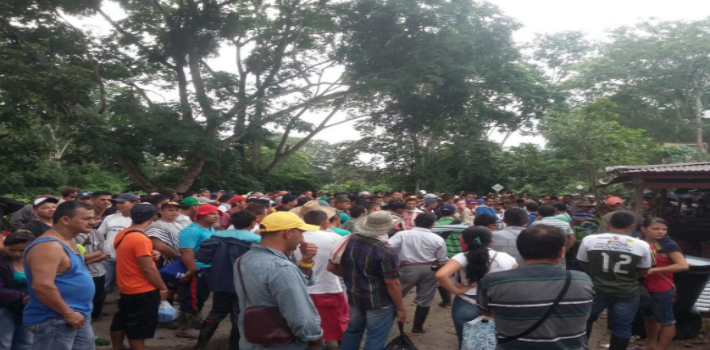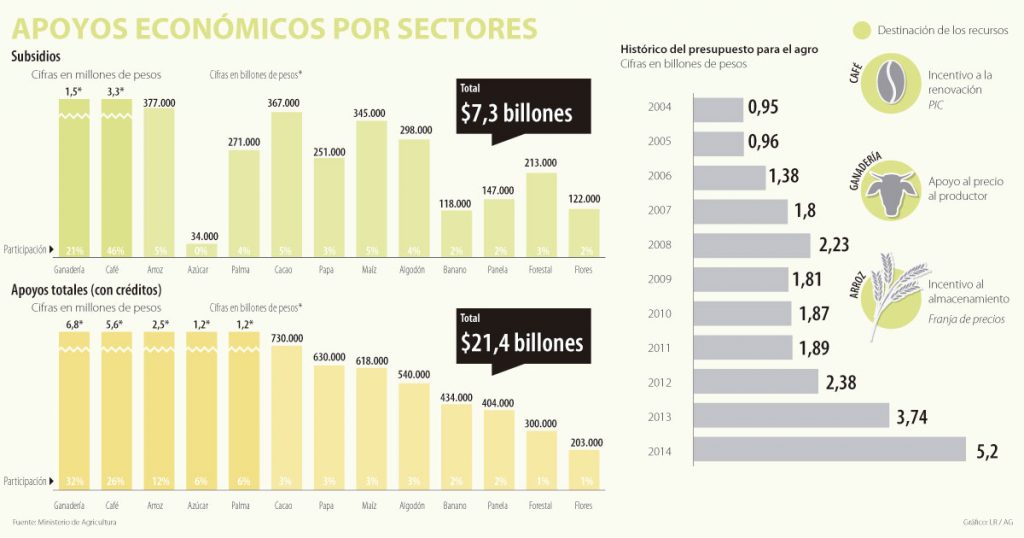
By Julian Villabona
EspañolSince May 29, agrarian unemployment in Colombia has become a problem again similar to the spike of 2013. Rural and indigenous community members took to the streets occurred after an alleged failure by the national government to pay agricultural producers subsidies that had been agreed upon two years ago.
According to Representative of the Council of Pueblos Jimmy Moreno, the government of Juan Manuel Santos has not completed payment of an annual COP $250 billion that was promised to indigenous and farming communities, which they had counted on for strengthening their productivity.
However, statistics show the Colombian agricultural sector is highly subsidized, with COL $7.3 billion delivered to different agricultural sectors in the form of subsidies, with COL $21.4 billion coming in total support between 2004 and 2014.

The central point of discussion between the national government and the rural communities was focused on the subsidies that, according to the latter, were needed so as to avoid being drastically affected by the entry of new products into the Colombian market. Such products enter Colombia under a free trade agreement, and are often much cheaper than what local farmers produce.
Officials responded saying they need to modernize and increase the competitiveness of the country’s local producers. However, a lot of farming sectors have been asking for subsidies from the government so they can have income equal to that which they would make if there were no outside competition.
- Read More: Colombia Legalizes Medical Marijuana
As a result, the farmers and indigenous people have begun protesting. The demonstrations have included roadblocks — most notably of the Pan-American Highway in the south of the country — with the intention of pressuring the government into distributing the promised money. They partially achieved their goal in that the Minister of Agriculture Aurelio Iragorri has announced a new agreement with some protesters.
Gobierno y la Minga Indígena firman acta que acuerda desbloquear la vía Panamericana @JuanManSantos @CristoBustos pic.twitter.com/mL8SeN3cMe
— Aurelio Iragorri V. (@aurelioIragorri) June 9, 2016
According to some critics, the agreements made between the national government and the agriculture sector will be fruitless if farmers don’t understand how necessary it is for them to modernize their production and achieve a higher level of competitiveness. If history repeats itself, the money that the government distributed will be insufficient for the demonstrators in the coming year, who will strike again.
According to political analyst Andrés Mejía Vergnaud,
They continue with block roads and threaten (the president). Santos is seen as a weak and indecisive president, and so they put the pressure on as their best strategy.
Moreno has used his Twitter account to express his thoughts about the protests, including the effectiveness of threatening the government when it reneges on payments it owes to the people. The message of the protest leader comes after more than 150 thousand workers joined the cause.
La mesa instalada con cric en Cauca no está en el marco de la minga Nacional, la minga sigue y el despeje de vías se dará con garantías.
— Jimmy Moreno (@Jminguero) June 9, 2016
So far, the protests and the roadblocks have left approximately 203 people injured, more than 100 people incarcerated and 3 dead. The protests have attracted controversy as well for the way riot police have handled the crowds.
 Versión Español
Versión Español












